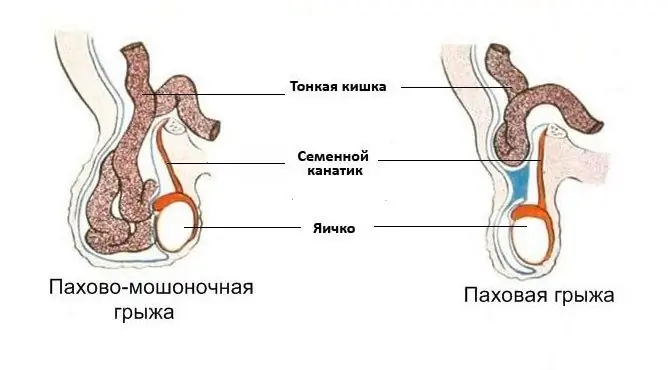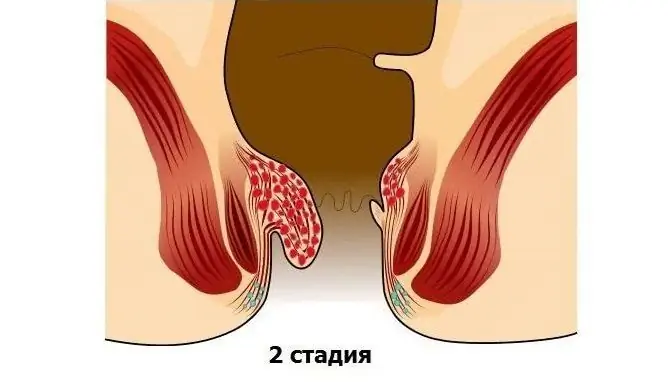- Author Rachel Wainwright [email protected].
- Public 2024-01-15 19:51.
- Last modified 2025-11-02 20:14.
Inguinal-scrotal hernia
The content of the article:
- Structure
- Specifications
- Symptoms
- Diagnostics
-
Treatment
- Operation
- Features of the treatment of children
- Possible complications
- Video
An inguinal-scrotal hernia is formed due to a defect in the muscular aponeurosis of the anterior abdominal wall and can refer to both congenital and acquired diseases.
Externally and in the photo, the hernia looks like an oblong swelling.

For the diagnosis of an inguinal-scrotal hernia, an examination and physical examination are sufficient
Structure
Three elements are the classic components of education.
| Element | Characteristic |
| Hernia gate | The place of the greatest divergence of muscle structures. Depending on the localization of the defect in relation to the inguinal ring, direct and oblique hernial protrusions appear (they are divided in the direction of movement along the inguinal canal). |
| Hernial sac | The area of the parietal peritoneum, which forms a palpable protrusion. In addition to the peritoneum, the sheaths of the hernial sac include all tissues in the direction of movement of the hernia. Not always the case. |
| Hernial sac contents |
It is usually represented by tissues lying directly in the hernia zone (spermatic cords, subcutaneous fatty tissue, testicular membranes). With giant hernial protrusions, it is possible to include the omentum or intestinal loops. |
Specifications
- A mass in one of the groin areas, painless on palpation, except in cases of infringement, when pain becomes the dominant symptom.
- The skin has no visible changes.
- Clear asymmetry of the scrotum (enlargement from the side of the lesion due to the hernial sac).
- Education in 80% is self-adjusted, the exception is cases of infringement, when the hernia persists for a long time.
- In children, bilateral lesions may occur, in adults, more often unilateral.
- In children, it is easily adjusted, often the only external manifestation is an expanded inguinal ring on one side (determined only by palpation).
Features of the disease:
- It can appear at any age. The difference between an inguinal-scrotal hernia in a man and in a child is only in the dominant cause of its occurrence: in adults - intensive loads, in children - a congenital anomaly.
- It is better visualized in a standing position and with physical exertion of the anterior abdominal wall (cough).
- Does not cause pronounced disturbances in the work of neighboring organs. The exception is infringement, which cause a pronounced violation in the microvasculature.
- Pathology is a classic of surgery and, as a rule, does not cause difficulties in diagnosis and treatment.
- Surgery is the only optimal treatment.
Symptoms
Symptoms vary with different types of disease.
| A type | Development features | Clinic |
| Congenital inguinal, which are able to pass into the groin-scrotal | They occur when the vaginal process of the peritoneum is not closed. With partial non-closure, cysts of the spermatic cord (an isolated cavity filled with a serous component) appear. |
Clinical manifestations: Bulging in the groin-scrotal region, which adjusts independently; · There is no pain; · General condition is satisfactory. It is infringed rarely and is often found in boys by accident (when bathing, changing clothes). |
| Acquired inguinal (oblique and straight) with transition to the scrotum |
Classic hernial protrusion. Oblique arises in the area of the inner inguinal ring, pass through the entire inguinal canal and then come to the surface in the area of the outer ring (more often straight lines descend into the scrotum). Straight lines arise directly in the projection of the outer ring. |
Clinical manifestations: · Slight soreness when straining, found during palpation; In large sizes, causes dysuric disorders (frequent urge to urinate); · In large sizes, causes discomfort when walking. |
| Restrained inguinal-scrotal | It arises as a possible complication of a congenital or acquired hernia. |
Clinical manifestations: Sharp pain in the zone of protrusion; Local discoloration of the skin (cyanosis); Swelling of adjacent tissues; Violation of the general condition (nausea / vomiting, fever); Obstruction phenomena (abdominal pain, delay in stool and gas discharge in the patient, fluid levels on X-ray images). |
| Irreducible inguinal-scrotal | Possible result of congenital or acquired hernia formation |
There are no acute clinical manifestations, the course is similar to a simple hernia. The only difference is the inability to reposition the contents of the hernia into the abdominal cavity. There is no infringement. |
The clinic also depends on the stage of the process. Consider the example of oblique hernias, since they more often than others pass into the scrotum:
- First stage. The hernia is located in the inguinal canal. Palpable only in 10-20% of cases.
- Channel. The hernial sac is located in the area of the external inguinal ring (classic inguinal hernia).
- Rope. The hernial sac exits through the groin ring and is located at different levels of the spermatic cord.
- Inguinal-scrotal - the hernial sac is located in the scrotum.
Diagnostics
Diagnostics does not require special methods, just examination and physical examination.
Treatment
Only surgical treatment is indicated.
- elective surgery in the case of typical hernias;
- emergency operation in case of infringement.
Operation
The operation is called hernioplasty.
Both general and local anesthesia can be used (with laparoscopy, only general anesthesia is performed).
Several methods of inguinal canal plasty have been developed:
- Depending on the access to the hernial sac (inguinal, extraperitoneal).
- Depending on the type of plastic surgery of the inguinal canal (with or without opening, with plastic of the posterior or anterior wall).
Currently, it is common to use non-tensioning techniques to prevent recurrence of hernias.
| Operation type | Description |
| Liechtenstein operation | The technique is based on strengthening the posterior wall of the inguinal canal and is the gold standard of treatment. It is performed under local anesthesia. A 5-6 cm long incision is made in the projection of the inguinal canal with layer-by-layer dissection of tissues to the aponeurosis of the external oblique muscle. Then it is dissected and separated from the muscle in the upper-anterior direction (3-4 cm up). This allows for sufficient mobilization of the wound and prevents infringement of the ilio-hypogastric nerve during mesh placement. Then the spermatic cord and the inguinal ligament are isolated and reach the inner inguinal ring. In the case of oblique hernias, the hernial sac is distinguished among the elements of the spermatic cord. After isolation of the bag, it is sutured and excised. Next, a special polypropylene mesh is modeled and positioned in accordance with the size of the hernia over the spermatic cord. It is fixed with a continuous suture to the pubic tubercle and inguinal ligament. With the help of a special non-absorbable suture, it is additionally fixed to the tendon part of the internal oblique and rectus muscles. The excess mesh is cut off. Then the aponeurosis of the external oblique muscle is sutured directly above the formed prosthesis, and then the wound is sutured in layers. |
| Transabdominal preperitoneal inguinal hernia repair (TAPP) | Refers to laparoscopic techniques. The operation begins with the placement of a trocar and a thorough revision of the abdominal cavity. The essence of the operation is to pull the hernial sac into the abdominal cavity. Isolation of the hernial sac is performed until it ceases to go into the inguinal canal. The size of the synthetic mesh prosthesis should be at least 10 cm. The mesh is cut before insertion in order to enclose all anatomical structures. It is introduced into the abdominal cavity in a folded state using an insert sleeve. It is fixed to the walls of the abdominal cavity with a special herniostapler tool. After attaching the mesh, the peritoneum is restored using the same instrument. Then the instruments are removed and 1-2 sutures are applied to the trocar wounds. |

Inguinal-scrotal hernias are not subject to conservative therapy, treatment is only surgical
Features of the treatment of children
In children, only plastic surgery of the inguinal canal is performed, the mesh is not installed unnecessarily - there is no pronounced deformation and atrophic changes in the muscles, therefore, there is no need for additional fixation.
In general, children have a shorter recovery period and fewer complications.
Possible complications
Complications are relatively rare. Possible consequences of a hernia:
- Relapse. It occurs more often after laparoscopic removal, since sometimes there is insufficient fixation of the inguinal ring, and its repeated divergence.
- Infringement. If this complication is suspected, immediate hospitalization and surgical treatment are required (optimally no later than 6-10 hours).
- Intestinal obstruction. It occurs exclusively with large hernial protrusions, sufficient for the penetration of the bowel loop.
- Crossing the spermatic cord. It occurs when the operation technique is not followed (accidental crossing or suturing of the duct). This condition has the same consequences as a vasectomy.
- Damage to vascular structures with the formation of hematomas. When large vascular structures are crossed, it may be necessary to impose an anastomosis in order to provide adequate blood supply to the tissues and organs of the scrotum.
- Damage to the nerve trunks with the onset of chronic pain syndrome.
Video
We offer for viewing a video on the topic of the article.

Anna Aksenova Medical journalist About the author
Education: 2004-2007 "First Kiev Medical College" specialty "Laboratory Diagnostics".
Found a mistake in the text? Select it and press Ctrl + Enter.






